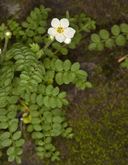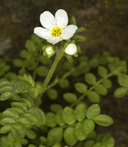notes This plant was the largest in size within a small population found growing on shaded, north-facing, (volcanic) rock ledges. It was a beauty and delight to behold.
It also turns out this population constitutes an interesting taxonomic find and prompts ID questions on the varietal level...as the white-flowered members of the species here, Polemonium pulcherrimum, have a somewhat complicated and confusing history of circumscriptions and synonymies in the literature (starting from J. M. Greenman's 1898 P. viscosum var. pilosum; Alice Eastwood's 1904 P. berryi and 1905 P. shastense; and a slough of other names derived from them). Moreover, this Pilot Rock population appears to constitute a range extension into Oregon, in terms of the distributions given in the most recent work on this group by Stubbs & Patterson in 2013.
So, here's the story...
I initially ID'd these plants using the Polemonium treatments in the 1993 Jepson Manual and also (since the plants were in Oregon, not California) in Abrams's 1951 ''Illustrated Flora of the Pacific States''. This led me to Polemonium pulcherrimum var. pilosum. Note that Abrams' discussion of P. pulcherrimum indicates he treated both J. M. Greenman's 1898 P. viscosum var. pilosum and Alice Eastwood's 1905 P. shastense as synonyms under the single varietal name of pilosum.
Stubbs & Patterson, in their 2013 paper here, resurrected Eastwood's shastense as a variety, and reviewed the confusing history of names and circumscriptions for the various forms of white-flowered P. pulcherrimum known from the western US. Their conclusion was to recognize two varieties: P. pulcherrimum var. pilosum and P. pulcherrimum var. shastense. Per their discussion, the characters of note for placing the Pilot Rock population here are:
* The 'near' California location (i.e. far southern Oregon); * The relatively low elevation of approximately 1700 m; * Petiole lengths were relatively short (generally < 10 mm); * Plants were greater than 7cm in size; * Leaves were viscid-glandular, while stems were sparsely long, white pilose (but not densely woolly); * Corollas were white and either lacked, or had just the slightest intimation of pink suffusing the veins.
Stubbs & Patterson gave a table for separating P. p. var. pilosum and P. p. var. shastense...their ''Table 3'' at the top of pg. 247 here. For comparison purposes, I've made a corresponding table below, incorporating the character info listed above in green font:
| P. p. var. pilosum | P. p. var. shastense |
|---|
| General Location | Washington | California ?| Elevation | 1524-1828 m | 2590-3900 m |
|---|
| Plant Size | 6-13 cm | 7-18 cm | Petiole Length | 8-10 mm | 10-33 mm |
|---|
| Pubescence | densely woolly | viscid glandular |
|---|
| Corolla Color | white | white with pink ? |
|---|
|
|---|
|
|---|
[Note: In my table above, I've corrected a critical error in Table 3 on pg. 247 of Stubbs & Patterson(2013) by interchanging the entries in their 5th row (labelled ''Pubescence'') to reflect the crucial last sentence at the bottom left of their pg. 247. That last sentence, and the corrected table, conform to the pubescence characters for the two varieties as originally described in Greenman(1898) and Eastwood(1905).]
Gazing at that table, things look rather muddy...the characters for the plants here spill almost equally into both columns...yielding no clear conclusion. Given such an ID log-jam, one might reasonably try to salvage things by giving lesser weight, as appropriate, to some of the characters listed in the table. For instance, the overlap in the given plant size spreads is substantial, and the intervals for petiole length agree at their extremes. Those characters might vary significantly (i.e beyond the given limits) with respect to highly localized factors like soil conditions, moisture, light, localized temps in growing season, etc...so one might diminish their weight here. It seems the last two character rows in the table...pubescence and color are the most critical and intrinsic. But it's probably best to turn to the original descriptions of pilosum and shastense for guidance.
Greenman's description of pilosum is quite brief, the main part is (green font emphasis mine):
''...entire plant covered with a spreading pilose pubescence intermixed with short glandular viscid hairs; leaflets usually less crowded or imbricated than in the type of the species; the calyx-lobes somewhat variable, oblong-ovate to distinctly oblong, obtuse or rounded at the apex; corolla white or pale blue with a yellowish center, 1 cm or less long. Collected by O. D. Allen in clefts of rocks on Goat Mountain, Washington, altitude 1540', July 6, 1896, no. 261.''
The two plants in my photos fit the above description quite well...except it's mainly the stems that have ''spreading pilose hairs'', rather than the ''entire plant''. In situations like this, it's best to examine the type on which the description was based, to ascertain possible ambiguity (or inadvertent error) in the description. As luck would have it, it turns Harvard University Herbarium has an online record for O. D. Allen's specimen no. 261, together with a fairly high-resolution image (though I wish it were a bit higher resolution). As far as I can tell, the discrepancy between the pilosity of the leaves and calyces in my plant and Greenman's isotype is not very large. I was expecting more conspicuous pilosity on the leaflets and calyces, along the lines of the image here of P. pulcherrimum var. pulcherrimum, from the about 5200' elevation on the east slopes of Mt. Ranier, about 110 km south of Goat Mountain, WA. Another voucher record, on the Consortium of Pacific Northwest Herbaria web site, provides this voucher image, from 5500' on Mt. Angeles on the Olympic Peninsula of northwest WA. It appears a bit more pilose on leaves and calyces than the Pilot Rock plants in my photos, but not by much. Based on the above, I'd say the plants in my photos would be well placed as P. pulcherrimum var. pilosum...and that my initial concern about the 'entire plant' not being sufficiently pilose appears to be more of a artifact of the imperfection of Greenman's description than of a critical discrepancy vis-avis the plants he used to name the variety. To my eye, the character of ''densely woolly'' given for pilosum in Stubbs & Patterson doesn't seem to match the isotype or Greenman's description.
Regarding shastense, again, it's probably best to refer to Alice Eastwood's original description...which is much more detailed than Greenman's was for pilosum. Note that, like pilosum, for shastense Eastman states ''stems and leaves [...] glandular pubescent''. The main difference vis-a-vis pilosum seems to be corolla color, with ''corolla white [...], veined and tinged with pink''. While the interiors of the corollas are not visible in the holotype image, the distinctively tinged and locally suffused pink veins are evident in all the current CalPhotos posts from Mt. Shasta under shastense. But note that Rob Preston's post Rainbow Mountain, about 10 miles NE of Mt. Shasta, is very similar to the Pilot Rock plants, which are about 45 miles to the north of Mt. Shasta.
On the other hand, as intimated by Greenman, the Mt. Lassen population (cf. images here, here, here, and here), though much higher in elevation than the Pilot Rock plants, appear almost as similar to them as Rob Preston's plant, and the image here has leaves that even look somewhat ''densely woolly pilose''...making it to seem to fit the notion of of var. pilosum in Stubbs & Patterson(2013).
We still haven't mentioned the current Jepson eFlora treatment. The problem there is that (based on Stubbs & Patterson?) it presumes var. pilosum does not occur in its CA coverage area, so the key takes anything that would fall into either var. pilosum or var. shastense to the latter. The pertinent couplet for the two varieties of P. pulcherrimum is:
8. Corolla lobes blue to purple; herbage sparsely glandular-hairy .....var. pulcherrimum 8' Corolla lobes white, generally with pink veins or tinge (individual flowers or plants rarely without pink); herbage densely glandular-hairy ..... var. shastense
In light of everything above, I would think it preferable to follow lead 8' in the Jepson eFlora key with an additional couplet like:
(Possible Alternative lead) 9. Corollas white AND tinged or having veins streaked with pink...var. shastense (Possible Alternative lead) 9'. Corollas white, lacking pink tinge or pink streaked veins.....var. pilosum
Looking for clarification on whether var. shastense (or pilosum) might already be known from Oregon, I checked the current Oregon Flora Project's 2016 checklist of Polemoniaceae. But, alas, the portion of that checklist covering genus Polemonium was compiled on 9/27/2000...before the publication of Stubbs & Patterson(2013). In fact, as far as I can tell, the main herbaria in Oregon and Washington currently have their databases for Polemoniaceae aligned with circumscriptions derived from Porter & Johnson(2000). And accordingly, their checklist and online voucher databases treat P. pulcherrimum var. pilosum as a synonym under (the typically blue-flowered) P. pulcherrimum ssp. pulcherrimum (cf. ''Editorial Comments 1'' here). This makes it difficult to find useful voucher info on the white-flowered P. p. var. pilosum ''needles'' in their P. p. var. pulcherrimum database ''haystack''.



